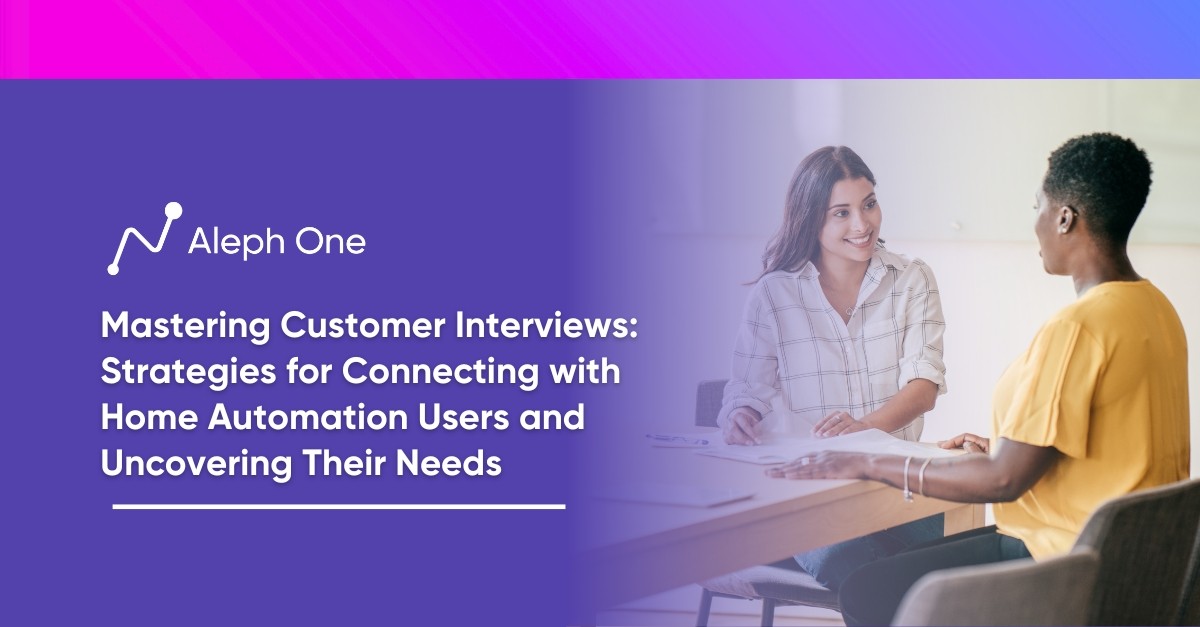Let’s work together to build something amazing. Share your project details and our team will reply to figure out the next steps to your success.

Staying ahead of customer needs and trends is paramount for companies in the home automation industry. While surveys and data analytics offer valuable insights, customer interviews provide a deeper understanding of users’ perspectives, behaviors, and unmet needs. This article explores the critical role of customer interviews in the success of home automation companies. Drawing on examples from companies like Ecobee and August Home, this article highlights how customer interviews are instrumental in shaping product roadmaps, driving innovation, and ensuring that smart home solutions truly enhance customers’ lives. It emphasizes the importance of active listening, observational research, data analysis, and turning insights into innovative solutions, providing a comprehensive guide for home automation companies to leverage the power of customer interviews for sustainable growth and innovation.

Why Customer Interviews Are Critical for Home Automation Companies
Home automation companies operate in an industry where customer needs and behaviors constantly evolve. What customers want and how they interact with smart home devices today may differ in just a few years. This makes gaining ongoing customer insights critical for companies to stay ahead of trends and develop innovative products that meet customers’ unmet needs.
Customer Interviews Offer Deep Insights
While surveys and data analytics provide a high-level overview, customer interviews offer deep insights into customers’ perspectives, behaviors, motivations, and pain points that quantitative methods alone cannot uncover. According to research from McKinsey, B2B companies that utilize customer insights, especially from interviews, experience up to 20% faster revenue growth and 25% higher profit margins.
Find Out How Customers Use Smart Home Devices in Daily Use
For home automation companies, customer interviews provide an opportunity to gain valuable insights into how customers use smart home devices in their daily lives and what they wish the technology could do for them. These insights help companies identify opportunities for new features, integrations, and even entirely new products.
Developing Ecobee’s SmartSensor & August Smart Keypad
For example, smart thermostat company Ecobee conducted customer interviews and found many customers wanted an easy way to control the temperature in just one area of their home. This insight led to the development of Ecobee’s SmartSensor, a remote temperature sensor that provides zone control. Smart lock company August Home also discovered through customer interviews that users wanted an easier way to give guests temporary access to their homes. In response, they developed the August Smart Keypad, a standalone smart lock that provides keyless entry using a custom access code.
Ongoing Customer Interviews
Conducting ongoing customer interviews at crucial points in the product development lifecycle helps home automation companies build solutions that meet customers’ needs and provide a desirable experience. Interviews also uncover insights that can influence a company’s long-term product roadmap and innovation strategy. They provide an essential feedback loop to help companies stay in tune with how they can improve their customers’ lives through smart home technology.
Customer interviews offer home automation companies a competitive advantage by providing a window into the customer experience that shapes vital business and product decisions. They are a research method that should be prioritized to drive innovation and growth.
Preparing for a Successful Customer Interview
Conducting a customer interview requires thoughtful preparation to yield valuable insights. First, determine your interview goal, such as understanding how customers use specific home automation devices or uncovering unmet needs. With a clear goal, you can develop targeted open-ended questions to guide the discussion.
Create an Interview Guide
Create an interview guide that lists questions and prompts to keep the conversation flowing. Start with broad questions about the customer’s home automation experiences and then dive into more specific questions about their needs, frustrations, and wish list items. For example, you might ask, “How do you currently use smart home devices?” Follow up with, “What do you wish the devices could do for you?” and “What problems do you frequently encounter?” These open-ended questions spark a rich discussion rather than short, superficial answers.
Choose the Right Interview Participants
You should also decide on the right interview participants based on your goal. For example, recruit households with children if you want to understand how families use whole-home automation. Or, if you’re going to explore needs related to home security, focus on interviewing customers who have purchased security systems. Screen participants to confirm they meet the criteria and can openly share their experiences.
With a well-developed interview guide and the right participants selected, you’re ready to conduct your customer interviews. During the interview, be an engaged listener by maintaining eye contact, nodding, and avoiding interruptions. Follow up on interesting comments to dig deeper while being careful not to ask leading questions. Your genuine interest and active listening will make participants comfortable expressing their opinions and unmet needs. With the proper preparation and interview skills, you’ll gain valuable insights to shape innovative solutions.
Master the Art of Active Listening
Conducting a successful customer interview requires mastering the art of active listening. As the interviewer, your role is to build rapport, ask follow-up questions, avoid interrupting, and listen for clues to unmet needs.
Build Rapport
Start by introducing yourself and the purpose of the interview to build rapport. Explain that the goal is to learn more about the participant’s experiences with home automation devices. Ask open-ended questions like “Can you walk me through how you use smart home devices in a typical day?” or “What do you like most about your smart home setup?” Follow up with prompts such as “Can you tell me more about that?” or “What do you mean by that?” to get the participant talking.
Avoid Asking Leading Questions
Avoid asking leading questions that suggest a particular answer. For example, say “How did you first get interested in smart home technology?” rather than “Did you first get interested in smart home technology because of the convenience?” Leading questions bias the participant and limit the discovery of new insights.
How to Practice Active Listening
Practice active listening by maintaining eye contact, nodding to show you are listening, and avoiding interrupting the participant. Pay close attention to the participant’s tone of voice and body language. The participant may say they find a device “useful,” but their tone and lack of enthusiasm reveal they are not fully satisfied. Ask follow-up questions to explore the root cause of their indifference.
Listen to Unmet Needs or Paint Points
Listen for clues to unmet needs or pain points like “I wish the app was easier to use” or “The system can be frustrating when the Wi-Fi goes out.” Ask the participant to describe their ideal solution to understand their needs better. These unmet needs and wishes point to opportunities for innovation.
Look for Patterns in Your Notes
After the interview, synthesize your notes and look for patterns across multiple interviews. What common unmet needs emerged? What workarounds or “hacks” did participants devise to overcome frustrations? These types of insights should shape your product roadmap and new feature development.
With practice, you will improve the subtle art of active listening. Conducting customer interviews is a skill that takes time to develop but will provide invaluable insights into how you can build products and experiences that truly resonate with your customers’ needs. The key is simply getting out of the building and starting a genuine conversation with the people who matter most – your customers.
Turn Insights Into Innovative Solutions
The key to conducting impactful customer interviews is turning the insights into solutions that address unmet needs. Home automation companies like Nest, Ecobee, and August Smart Locks have developed innovative new products based on a deep understanding of customer pain points uncovered through interviews.
Determine Areas to Focus on for Solutions
Once you have analyzed the interview data and identified key themes, determine which areas to focus on for solutions. Look for frequently mentioned themes that indicate a strong unmet need or represent an opportunity for real innovation. These insights should directly map back to improving the customer experience or solving a problem.
Start Broad then Narrow
When ideating solutions, start broad then narrow. Consider how key themes could translate to new products, features, services, or business models. Look for ways to combine multiple insights into an impactful solution. Get input from different team members to spur creative thinking. Then evaluate each solution based on feasibility, implementation cost, and potential customer value.
Gain Innovative Solutions from Customer Insights
The most innovative solutions often come from the most surprising customer insights. August Smart Locks developed an auto-unlock feature after learning from interviews that users with their hands full struggled to manually unlock doors. Nest created the Nest Protect smoke alarm after discovering customers disabled existing alarms due to frequent false alerts.
Gain a Competitive Advantage with Customer Interviews
Customer interviews provide a competitive advantage for home automation companies by uncovering unmet needs that lead to new product innovations. But the key is listening with an open and curious mindset, analyzing the data in a structured way, and then developing solutions that directly map back to addressing customer pain points. This process of turning insights into solutions is what fuels real innovation.
FAQ
How do customer interviews drive product innovation in home automation companies?
Customer interviews in home automation companies are instrumental in propelling product innovation by fostering a deeper understanding of customer needs, expectations, and usage patterns. These discussions allow companies to discover unmet necessities and potential areas for improvement that are not apparent through standard feedback or broad-level analytics. This unique, first-hand insight serves as a catalyst for tailoring existing services or for introducing new, innovative products that align with customer preferences and enhance their overall experience.
What strategies should home automation companies implement to gain more effective results from customer interviews?
For more effective outcomes from customer interviews, home automation companies should implement strategies such as meticulous planning, development of thorough interview guides, and careful selection of participants. The mission of the interview should be explicit and firmly aligned with the company’s central goal. The questions should be nicely structured and open-ended to encourage profound and detailed responses. Also, the chosen interviewees should symbolize the diverse demography of the company’s customer base to ensure the gained insights are comprehensive, representative, and useful in augmenting product development strategies.
How is active listening a crucial skill for conducting successful customer interviews?
Active listening is a pivotal skill for successful customer interviews because it facilitates in-depth understanding of the customer’s viewpoint, queries, and concerns. The practice of active listening involves maintaining eye contact, nodding, and avoiding interruptions to create an engaging and comfortable environment for the interviewee. This approach aids in gaining richer feedback. Attentive listening also allows the opportunity to detect and explore implicit clues and hidden insights, which may potentially lead to groundbreaking innovative ideas.
Get the latest news and updates from Aleph One in your inbox.



